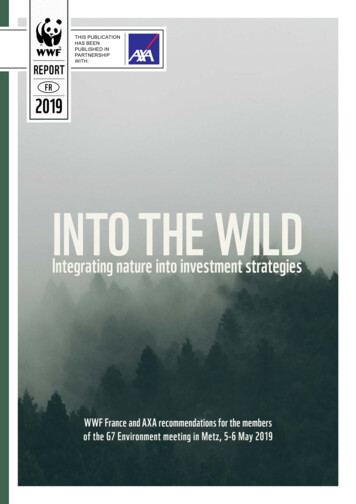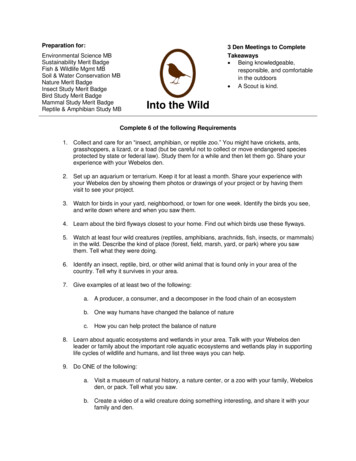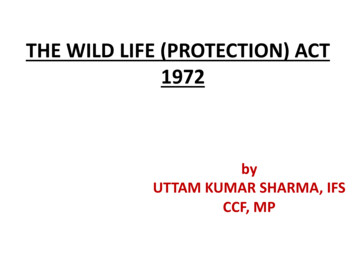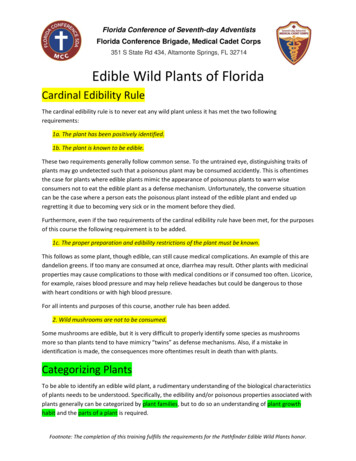
Transcription
REPORTTHIS PUBLICATIONHAS BEENPUBLISHED INPARTNERSHIPWITH:FR2019INTO THE WILDIntegrating nature into investment strategiesWWF France and AXA recommendations for the membersof the G7 Environment meeting in Metz, 5-6 May 2019
TABLE OF CONTENTSAcknowledgments4Editorial Isabelle Autissier5Editorial Thomas Buberl6Executive summary and recommendations8Introduction13CHAPTER I – THE BANKRUPTING OF NATURE141 - Clarifying the central concepts and the main issues16WWF From nature to human well-being16WWF is one of the world’s largest and most experiencedindependent conservation organizations, with over5 million supporters and a global Network active inmore than 100 countries. Current trends in nature and suspected retroactions on human populations19 The subsequent need to ensure ecological resilience and to comply withecological limits20 Integrating nature into economic systems: natural capital, weak andstrong sustainability22WWF’s mission is to stop the degradation of the planet’snatural environment and to build a future in which humanslive in harmony with nature, by conserving the world’sbiological diversity, ensuring that the use of renewable naturalresources is sustainable, and promoting the reduction ofpollution and wasteful consumption.AXAThe AXA Group is a worldwide leader in insurance and assetmanagement, with 171,000 employees serving 105 millionclients in 61 countries. The AXA Group is included in the maininternational SRI indexes, such as Dow Jones SustainabilityIndex (DJSI) and FTSE4GOOD. It is a founding member ofthe UN Environment Programme’s Finance Initiative (UNEPFI) Principles for Sustainable Insurance and a signatory of theUN Principles for Responsible Investment. As early as 2015, atthe COP21 in Paris, AXA paved the way for the financial sectorin terms of climate leadership by being the first internationalinsurer to withdraw from the coal sector and, in 2017, fromthe oil sands sector. In 2019, the Group’s climate strategy wasextended to all its businesses (investment and insurance) andincluded also biodiversity conservation.Design and infographics: MuscadeCover photograph: Staffan Kjellvestad – UnsplashDocument published in October 2019Any reproduction in full or in part must mention the title andcredit the above-mentioned publisher as the copyright owner.All rights reservedWWF France, 35-37 rue Baudin - 93310 Le Pré Saint-Gervais.2 - Financial institutions’ role and nature: taking stock of the mobilisation onclimate change24 Linking financial institutions and nature24 The precedent of climate change: a rising concern for financial institutions29CHAPTER II - DE-RISKING NATURE321 - Identifying how nature degradation can impact financial institutions342 - Managing nature-related risks35 ESG strategies: paving the way to de-risking nature35 Engaging companies41 Bridging the data gap443 - Seizing new opportunities47 Differentiation and opportunities for branding47 Opportunities for new financial products47 Bringing opportunities to the market48 New investment opportunities48CHAPTER III - ALIGNING WITH NATURE501 - Transitioning towards portfolios integrating ecological limits: the case ofcompanies financial institutions invest in52 Measuring corporates’ pressures and impacts on nature: footprintingmethodologies52 Establishing ecological limits and aligning the business activity56 Communicating absolute sustainability: methodologies for non-financialdisclosure, integrated reporting, and integrated accounting612 - Transitioning towards portfolios integrating ecological limits: the case offinancial institutions64 Measuring portfolios’ impacts on nature64 Establishing ecological limits and aligning portfolios66Conclusion71References72Annex76
EDITORIALISABELLE AUTISSIERACKNOWLEDGMENTSThis report was commissioned by the French Ministry ofEnvironment (Ministère de la Transition Ecologique etSolidaire) for consideration at the G7 Environment MinisterialMeeting in May 2019.It relies on the analysis of the current, relevant availableliterature and 23 interviews conducted from February toMarch 2019 and the list of which is available in the annex.AXA and WWF France co-produced and support therecommendations that are set out from pages 8 to 10 of thedocument.We would like to thank the persons who have kindly acceptedto share their expertise and insights to inform this report:Julien Calas, Anne Chetaille, Guillaume Chiron, OdileConchou, Naig Cozannet, Aurélien Guingand, Gilles Kleitz(Agence Française de Développement, AFD), AlexandreRambaud (AgroParisTech), Sylvain Goupille (Athelia), JulieAnsidei, Maryline Dutreuil-Boulignac (Autorité des marchésfinanciers, AMF), Fabien Quétier (Biotope), Julie Miller (BNPParibas), Robert-Alexandre Poujade (BNP Paribas), EliseBouffies (Carrefour), Joshua Berger (CDC Biodiversité), HaroldLevrel (CIRED), Eric Campos (Crédit Agricole), Damien Friot(Ecometrics), Claire Varret (Electricité de France, EDF), SylvieGillet, Nadine Laurent (Entreprises pour l’Environnement,EPE), Pierre Yves Le Stradic (Ethifinance), Johan Lammerant,Anne-Marie Bor (EU Business @ Biodiversity Platform),Jean-Louis Weber (Ecole Normale Supérieure de Lyon), BenoitLallemand, Ludovic Suttor-Sorel (Finance Watch), Thuy-TienGluck (HSBC), Gautier Quéru (Mirova), Clément Chenost,Oriane Plédran (Moringa), Katia Karousakis, Geraldine Ang(Organisation for Economic Co-operation and Development,OECD), Richard Mattison (Trucost) and Coline Jacobs,Géraldine Petit (Veolia).We would further like to thank the French Ministry ofEnvironment (Ministère de la Transition écologique etsolidaire) for commissioning us to prepare this report and fortheir continuing support throughout the project. WWFThis report was produced by WWF France, with the inputsand the careful rereading of AXA.Global wildlife populations have declined on average by60 percent in the past 40 years, largely due to threatsand pressures induced by human activities. This isan alarming wake-up call that nature is in a state ofemergency. And it is not just wildlife that is in crisis.Each year, around US 125 trillion worth of ecosystemservices are provided to the global economy throughdrinkable water, food and pollination, fresh air, heatabsorption, and forests & oceans that soak up carbondioxide – the equivalent of 1.5 times the global GDP.But these crucial ecosystem services provided by nature, which underpin humanwell-being and survival, are at risk – as the last Global Assessment Report of theIPBES demonstrates again. Overexploitation, habitat loss and pollution, amongothers, generate an ecological debt, which future generations will have to bear.We need a global action to bend the curve of nature loss, protect our natural capitaland secure the future of humanity. For that, we have before us an unparalleledopportunity as we head into 2020. In China in autumn 2020, the world leaderswill gather to agree on a new 10-year strategic plan for biodiversity under the UNConvention on Biological Diversity. This framework will have to set the targets andstrengthened mechanisms to put us on the path towards a more sustainable future.We need a real New Deal for Nature and People where everybody has a role toplay – from business to civil society, governments and local authorities, youth andindigenous people, private finance actors and development banks – to, altogether,reverse the trend of nature loss and preserve our natural capital. This deal shouldfocus on tackling the underlying root causes of nature’s decline for the benefit ofPeople and the Planet. We need a New Deal for Nature and People to unite worldleaders behind the biggest issue of our generation and catalyze a new movement thatcan and will preserve the habitability of our planet.That is why WWF France is proud to publish this report together with AXA, oneof the first institutional investors to have really engaged in the fight againstclimate change.We thank the French Ministry for the Ecological and Inclusive Transition, whichcommissioned this report for the G7 Environment Ministers meeting in May 2019.It is the first time a leading global institutional investor and an internationalenvironmental NGO are exploring together the consequences of biodiversity lossfor investors and how the financial sector can have a positive impact to help protectand restore nature for the benefit of the whole society. It is a first step on a long andnecessary path towards a future where people can live in harmony with nature.Isabelle Autissier,Chairman, WWF FranceThe authors of this report, Hugo Bluet, Ciprian Ionescu,would also like to thank Renaud Lapeyre, Jochen Krimphoffand Marine Braud from the WWF France for their preciousadvices, as well as the MAVA Foundation for its support to theWWF France work on natural capital.Finally, many thanks to Sabrina Müller and Emma Gnidulawho have helped throughout the project and without whom itwould not have been possible to publish the report in such ashort period of time.Into the wild - Integrating nature into investment strategies page 5
EDITORIALTHOMAS BUBERLAddressing eroding biodiversity is a complex butincreasingly pressing challenge. Nature produceselements essential to human activity and to our verysurvival, from food and shelter to medicines’ activeingredients. Moreover, diverse ecosystems are key totackling climate change, as flourishing forests and wellpreserved oceans absorb carbon emissions. Conversely,climate change accelerates biodiversity loss, creating avicious circle. Our dependence on diverse ecosystemsto thrive, if not survive, is therefore not to be doubted. BENJAMIN BOCCASThe implicit contributions of each species in our economies are also far-reaching:their roles can be seen as “services” provided free of charge by nature. For example,artificial pollination would cost an estimated 153 billion euros per year, generatinglabour and technological costs far exceeding any economic viability. Yet speciesare disappearing at a fast rate, endangering these services and threatening humanintegrity. Whilst this situation has not yet attracted as much political and mediaattention as the equally challenging concerns related to climate change, more andmore analyses are starting to highlight the rate of species decline and its inherentthreat to human welfare.Finally, the adoption by governments of international science-based biodiversitytargets can help provide further clarity. General aspirations will not be sufficient togenerate tangible outcomes. Only then, provided these targets are clear enough, maycompanies, financial institutions, and civil society organizations attempt to translatethese nature conservation objectives into investment strategies.We are happy to have, thanks to the mission we were given by the French Ministry ofEnvironment, the opportunity to share our experience and learnings on responsibleinvestments and insurance with WWF, a world leading NGO on the fight forpreserving biodiversity. We are aware that this is only the starting point of a longjourney which will require a much broader collaboration, dialogue and mobilizationof governments, private sector, international organizations, regulators and civilsociety. It is crucial that we build collective awareness and willingness to take action.Thomas Buberl,CEO, AXA GroupAs a company which, over the past 5 years, took important decisions in the fightagainst climate change, we are convinced that the preservation of biodiversityrequires an equally broad collective commitment from all stakeholders: fromprivate sector actors, including financial institutions, to governments, NGOs andcivil society.The potential loss of key ecological services endangers not only populations butalso certain businesses that depend on them and can therefore become a concernfor investors. Investors’ ability to understand and map these potential risks wouldenable them to identify opportunities and in doing so, help support solutions ratherthan environmentally unsustainable business practices.This is why AXA decided in 2018, in the context of the “Act4Nature” project, toinvestigate this issue, by conducting an analysis of our exposure to biodiversityrelated risks and opportunities in our insurance and investment activities. In 2019we decided to support WWF’s development of this report, which is a first attempt tomap existing initiatives and call for a new public-private collaboration.Insurers, in their capacity as risk carriers, can leverage their expertise to providesolutions. We also have a strong role to play by engaging with the investmentcommunity, not least in sectors and companies that are committed to “transition”towards more sustainable activities. Having been among the first largeinstitutional investors engaged in the fight against climate change, we know thatthe financial sector cannot drive sustainable change on its own: operating in apredictable environment, relying on robust and harmonized methodologies, usingclear scientific definitions and being able to have sufficient “investment depth”to progressively shift investments towards the targeted sectors are key to ensurea positive impact in the long run. Only this way can we avoid generating binary,pro‑cyclical effects. A forward-looking, dynamic view will also be essential toavoid the pitfalls of static approaches.Into the wild - Integrating nature into investment strategies page 6Into the wild - Integrating nature into investment strategies page 7
Executive summary and recommendationsEXECUTIVESUMMARY ANDRECOMMENDATIONSExecutive summary and recommendationsSEEING THE BIGGER PICTURE: BEYOND CLIMATE,FINANCIAL INSTITUTIONS MAY BE EXPOSED TOTHE “BANKRUPTING” OF NATURENature is currently being degraded at anunprecedented pace and scale. The rate of globalloss of nature has been increasing drastically in the last50 years, leading to a global environmental crisis.The degradation of our planet’s natural ecosystems, suchas the oceans or land-based ecosystems is underminingits ability to provide vital goods and services that enable our economies to thrive.IF COMPARED TO THEWORLD’S TOP 10ECONOMIES, THE OCEANWOULD RANK 7TH WITH ANANNUAL VALUE OF GOODSAND SERVICES OF 2,500 BILLIONIS NOT THE ONLY PIECE OFTHE NATURE “PUZZLE” FORFINANCIAL INSTITUTIONSTHE ABSENCE OFMATURE, EFFECTIVEMETHODOLOGIES HINDERSFINANCIAL INSTITUTIONS’CAPACITY FROM HAVING ACOMPREHENSIVE VIEWOF IMPACTS ON NATUREConcerns over environment-related threats, starting with climaterelated financial risks, are growing. Since the launch of the Taskforceon Climate-related Financial Disclosures (TCFD), a growing number of policymakers have been acknowledging the importance of climate change for financialinstitutions. The mainstreamed mobilization of companies and financial institutionson climate can inspire similar initiatives to address other nature-related issuessuch as biodiversity; but systematically replicating the same approach is not theanswer. For instance, it might be useful to take stock of this approach and shift to amore integrated and impactful strategy: investing in and accompanying countries,companies and projects supporting the transition to a low carbon economy,a healthier and a fairer & more resilient society.We recommend to launch a Task Force on Nature Impacts Disclosures,to create the conditions to transition towards protection, restorationand promotion of biodiversity. Financial institutions have an importantleadership role to play in supporting awareness and decision taking aroundbiodiversity loss. Achieving meaningful change, however, will require abroad-based coalition gathering the full spectrum of actors that are part ofthe issue and of the solution. With this Task Force, we recommend to fosteran open dialogue with the private & public sector, including policymakers,with the objective to promote cross sectorial and cross border engagement.This Task Force should identify and analyze business activities that havea material impact on biodiversity as well as activities with “transition”potential to support biodiversity protection and restoration. This analysisshould be careful to avoid pitfalls that would hamper transition effortsrather than encourage them, such as: generating pro-cyclical effects byhighlighting niche activities only, or creating rapid, uncontrolled exclusionmechanisms that would lead to sudden divestments from companies at amoment when they need to invest on their transition efforts.Into the wild - Integrating nature into investment strategies page 8Identifying impacts on nature is an essential starting point to analyse,manage and ultimately report on them. For this purpose, the following reportproposes to review existing frameworks to understand business dependencies onecosystem services and their impacts on nature, to provide financial institutionswith an insight into existing initiatives.RECOMMENDATION 2To improve on methodologies, we urge non-financial rating agenciesto ensure the inclusion of material biodiversity considerations withintheir ESG criteria and rating methodologies. We also advise governmentsto help structure the market for non-financial rating agencies by way ofmore rigorous accrediting processes. The Task Force should review howto best integrate biodiversity impact measurement into existingframeworks on climate change and ESG criteria and not create anew, separate framework, which would risk creating undue complexityand hampering mobilization rather than fostering it. In terms of availabledata, we advocate for governments to create conditions to facilitate theharmonization of biodiversity-related data, for instance through thedevelopment of open source platforms, which would containinformation on the transition plan of private and public actors.Crossing the ecological limits of our planet may also put the profitabilityof some investments at risk. Certain financial returns are inextricably linked tonature through the dependencies and impacts of economic activities they finance.For example, a European pharmaceutical company lost almost 40% of its marketcapitalization in less than one year, causing shareholders billions in losses, afteracquiring an agrochemical company accused of causing adverse impacts on beepopulations and facing multiple health-related trials.RECOMMENDATION 1CLIMATENAVIGATING THE ISSUES ASSOCIATED WITH NATURE DEGRADATION - ANDTHE OPPORTUNITIES FOR ITS PROTECTIONIN THE SHORT RUN,EXTRA-FINANCIALAGENCIES ARE PIVOTALFOR MAINSTREAMINGAND HARMONISINGASSESSMENTTOOLS EVALUATIONMETHODOLOGIESThe lack of accurate, comprehensive and tailored nature-related dataprevents financial institutions from developing investment strategiestaking them into account and engaging effectively with companies.While tools for sectoral and geographical analyses of assets are emerging, there is aknowledge gap by non-financial companies on their value chain. This does not allowthem to monitor their impact/dependency relation on nature in a comprehensive wayand, in turn, to provide financial institutions with reliable and useful data. In theshort term, financial institutions can use the ratings and information provided byextra-financial agencies that are supposed to have larger datasets, proxies and scoringmethodologies. These methodologies are largely heterogeneous and are unlikely toprovide standardized and comparable information. In the longrun, the developmentof comprehensive metrics and conventions for reporting on them should beencouraged, either by market players and financial rating agencies, or by regulators,or via new forms of collaboration.RECOMMENDATION 3The Task Force should include institutional investors and develop aframework for investors to use in analyzing biodiversity risk andengaging with the businesses in which they invest, especially inthe sectors that can be most damaging for biodiversity.This framework should promote a direct dialogue with businesses ontransition towards protection, restoration and promotion of biodiversityand appropriate reporting.Into the wild - Integrating nature into investment strategies page 9
Executive summary and recommendationsTHE BIOFIN ESTIMATES THATTHE NEEDS OF FINANCIALFLOWS TO PROTECT NATURERUN UP TO US 440BNThere are also promising opportunities for financial institutions in meetingthe rising societal demand for nature conservation. Among them are the potentialfor new financial products, investments, and markets as well as early mover advantages.Private-public financing solutions can play a decisive role in bridging the ever wideninggap between the need for new investments to protect nature and current capital flows.RECOMMENDATION 4We propose that governments create the conditions for a continuing andconstructive dialogue between public authorities and the full spectrum ofprivate sector actors concerned by these issues with a view to addressingrising societal demand for nature conservation. This should include specificinitiatives to raise public awareness including, for example, such as labelsfor financial products with a positive impact on nature.EXPLORING AN INTEGRATED SUSTAINABILITY APPROACH: TAKING INTOACCOUNT ECOLOGICAL LIMITS INTO INVESTMENT STRATEGIESThe risks and opportunities for financial institutions in managing theprotection of nature may not be enough to preserve its ecological limits ormaintaining the resilience of our biosphere. This is because in the conventionalapproach to pressures, mitigation is neither systematic nor built to fit within ecosystemfunctioning. A new ecological approach to integrating nature into financial institutionsin order to address this issue in a more systematic way is required. In the climatecontext, a similar approach – that is the call for alignment with the Paris Agreementin absolute terms – has attracted a considerable amount of attention among variousactors of civil society as well as public and private organizations. Many financialinstitutions are working towards this objective, in a “test and learn” phase.RECOMMENDATION 5Governments should establish clear priorities in this field of biodiversityprotection since it is particularly vast and holistic and they should encourage thefull spectrum of actors (private and public) concerned by these issues to be partof this effort. Governments should provide visibility to economic actors on areasthat are the most sensitive and where transition efforts should urgently start.Ensuring financial activities are compatible with the viability of ecosystemfunctionality is a major issue, with three main considerations:1) understanding, characterizing, quantifying and monitoring the impact on nature of theactivities investors are financing,2) defining the level of impact that can secure ecological functionalities and the resilience ofthe biosphere,and 3) managing business and financial activity in order to maintain this level of impact.There are two complementary paths for integrating of these considerations intofinancial strategy. The first path, which is already underway, is initiated by companies. Itrequires them to measure their impacts, define individual ecological limits and to make thisinformation available for financial institutions. The second path, which is only now emerging,is initiated by financial institutions. It assumes that the financial institutions measurethemselves the impacts of their portfolios on nature, and define associated ecological limits.Into the wild - Integrating nature into investment strategies page 10
IntroductionINTRODUCTIONReversing the alarming degradation of nature willinevitably require collective action. Achievingmeaningful change will require a broad-based coalitiongathering the full spectrum of actors that are part ofthe issue and of the solution, among which the financialsector has a key role to play. The repeated and sciencebased warnings of the implications of the environmental crisis on the economyshould not be underestimated by investors. On the contrary, the financial sectorshould take advantage of the numerous financial opportunities that the conservationand restoration of nature presents. On the one hand, financial institutions face newchallenges stemming from the degradation of nature; but on the other they are partof the solution toward its preservation.In contrast to climate, standardized data and methodologies do not yet exist forother nature-related risk analysis. There are no “tons of CO₂” to factor in whenit comes to mitigating biodiversity loss. As a result, financial institutions are notyet capable of measuring, monitoring or reporting the impacts and dependenciesof their portfolios on nature in a harmonized manner. This also prevents themfrom assessing the ensuing nature-related risks and opportunities and ultimatelychanging their investment behaviour.Several tools are currently under development that aim to capture the impact offinancial institutions on nature – we are not starting completely from scratch onbiodiversity metrics. While none of them are yet sophisticated enough to be appliedat scale, they represent useful foundations for further development nonetheless.This report will review existing initiatives regarding their analysis of nature-relatedimpacts, risks, and opportunities for financial institutions (in particular for theirinvestment activities into large corporates¹).In parallel with commissioning this report on the links between nature-related risksand private financial institutions, the French Ministry of the Environment also askedthe OECD to explore Biodiversity Finance and the Economic and Business Case forAction (OECD, 2019).¹Given the time constraint for conducting the interviews and drafting the report, it focusses oninvestment activities into corporate equity and debt markets. As a result, other types of financialactivities and of investments (real estate, SMEs ) have not been explored in this report.Into the wild - Integrating nature into investment strategies page 13
NO ONE CARES, UNSPLASHChapter ITHE BANKRUPTINGOF NATUREThe interrelations between natureand financial institutions
Chapter I - The bankrupting of nature1 - CLARIFYING THECENTRAL CONCEPTSAND THE MAIN ISSUESChapter I - The bankrupting of nature1.1 FROM NATURE TO HUMAN WELL-BEINGNature is a general term that is usually used to referto the biosphere, i.e. to all ecosystems worldwidecollectively, or sometimes to specific ecosystems.Ecosystems are defined by the Convention on BiologicalDiversity (CBD) as dynamic complexes composed of abiotic fraction (i.e. communities of living organismssuch as plants, animals and microorganisms) andan abiotic one (i.e. the non-living environment)that interact together and form a functional unit(United Nations, 1992). The ecosystem concept is interrelated to biodiversity, whichcorresponds with “the variability among living organisms from all sources including,inter alia, terrestrial, marine and other aquatic ecosystems and the ecologicalcomplexes of which they are part; this includes diversity within species, betweenspecies and of ecosystems” (United Nations, 1992).Figure 1 illustrates the “ecosystem services cascade” described above, i.e. howecosystem functions are transformed into monetary value. Provisioning: All nutritional, non-nutritional material and energetic outputs fromliving systems as well as abiotic outputs (e.g. crops, animals for nutrition, etc.) Regulation and maintenance: All the ways in which living organisms can mediateor moderate the ambient environment that affects human health, safety orcomfort, together with abiotic equivalents (control of erosion, pollination, stormprotection, disease control, etc.) Cultural: All the non-material, and normally non-rival and non-consumptive,outputs of ecosystems (biotic and abiotic) that affect physical and mental statesof people (health or enjoyment through active interactions, symbolic or religiousmeaning, existence value, etc.)The abiotic dimension was added in the last version of the CICES. It highlightedadditional abiotic services following the same structure as the biotic ones:provisioning (wind energy, geothermal, etc.), regulation and maintenance (regulationof liquid flows, dilution of wastes, etc.), and other cultural services.From ecosystem services, human populations can collect different types of benefits,which can either have a monetary aspect (and be evaluated economically) or someother positive characteristics (e.g. health, social, conservation values).Into the wild - Integrating nature into investment strategies page 16SUPPORTING ORINTERMEDIATE SERVICESBiophysicalstructure orprocess(e.g. woodland habitator net primaryproductivity)THE SOCIAL AND ECONOMIC SYSTEMFINALSERVICESFunction(e.g. slowpassage ofwater, orbiomass)GOODS AND BENEFITSThe ‘productionboundary’Service(e.g. floodprotection, orharvestableproducts)Limit pressures viapolicy action?Ecosystem characteristics, structures, and processes control ecosystem functions, i.e.the properties of ecosystems that are useful for human populations. The MilleniumEcosystem Assessment (MA, 2005) specifies that there are four types of ecosystemfunctions: production (e.g. production of food, medicinal products, etc.), regulation(e.g. water regulation, biological control, etc.), habitat, and informational (e.g.aesthetics, culture, etc.). These functions create ecosystem services (comprising alsogoods derived from ecosystems) which are their contributions to human well-being:in other words, all the ecological outcomes that ecosystems generate and that canultimately benefit people.The Common International Classification of Ecosystem Services (CICES; cf. HainesYoung and Potschin, 2018) references three types of ecosystem services:ENVIRONMENTFigure 1. The cascade model(Haines-Young et Potschin, 2018)Benefit(e.g. contributionto aspects ofwell-being suchas health andsafety) PressuresCICESValue(e.g. willingness to payfor woodlandprotection or for morewoodland, orharvestable products)The benefits derived from ecoæsystems are diverse and
Into the wild - Integrating nature into investment strategies page6 Into the wild - Integrating nature into investment strategies page7 Addressing eroding biodiversity is a complex but increasingly pressing challenge. Nature produces elements essential to human activity and to our very survival, from food and shelter to medicines' active








![INDEX [randycherry ]](/img/21/x-20-20tv-20fakebook-20-20hal-20leonard.jpg)

